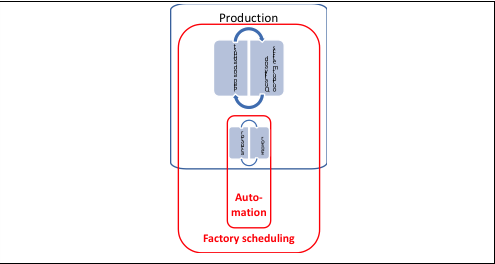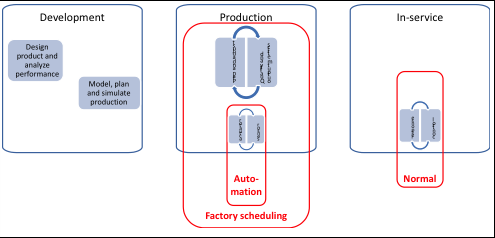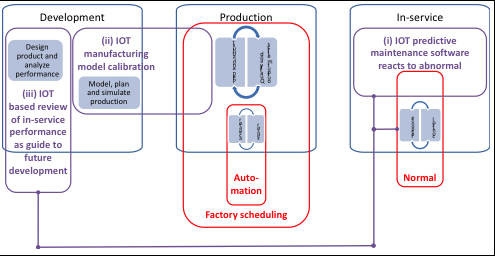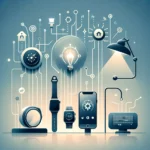I believe there is a part of the rich history of software development that will be a guiding light, and will support creation of the software that will run the Internet of Things (IoT). It’s all a question of scope.
Figure 1 is a six-layer architecture, showing what I consider to be key functional and technology groupings that will define software structure in a smart connected product.
The physical product is on the left. “Connectivity” in the third box allows the software in the physical product to connect to back-end application software on the right. Compared to a technical architecture, this is an oversimplification. But it will help me explain why I believe the concept of “scope” is so important for everyone in the software development team.
Scope is a big deal
The “scope” I want to focus on is a well-established term used to explain name binding in computer languages. There are other uses, even within computer science, but for now, please just exclude them from your thinking, as I am going to do.
The concept of scope can be truly simple. Take the name of some item in a software system. Now decide where within the total system this name is a valid way to refer to the item. That’s the scope of this particular name.
(Related: What newcomers to IoT plan for its future)
I don’t have evidence, but I imagine that the concept arose naturally in the earliest days of software, with programs written in machine code. The easiest way to handle variables is to give them each a specific memory location. These are global variables; any part of the software that knows the address can access and use these variables.
But wait! It’s 1950 and we’ve used all 1KB of memory! One way forward is to recognize that some variables are used only by localized parts of the software. So we can squeeze more into our 1KB by sharing memory locations. By the time we get to section two of the software, section one has no more use for some of its variables, so section two can reuse those addresses. These are local variables, and as machine code gave way to assembler languages and high-level languages, addresses gave way to names, and the concept of scope was needed.
But scope turned out to be much more useful than just a way to share precious memory. With well-chosen rules on scope, computer languages used names to define not only variables, but whole data structures, functions, and connections to peripherals as well. You name it, and, well yes, you could give it a name. This created new ways of thinking about software structure. Different parts of a system could be separated from other parts and developed independently.
A new software challenge
There’s a new challenge for IoT software, and this challenge applies to all the software across the six boxes in Figure 1. This includes the embedded software in the smart connected device, the enterprise applications that monitor and control the device, as well as the software-handling access control and product-specific functions.
The challenge is the new environment for this software. These software types and the development teams behind them are very comfortable operating in essentially “closed” environments. For example, the embedded software used to be just a control system; its universe was the real-time world of sensors and actuators together with its memory space and operating system. Complicated, but there was a boundary.
Now, it’s connected to a network, and it has to send and receive messages, some of which may cause it to update itself. Still complicated, and it has no control over the timing, sequence or content of the messages it receives. Timing and sequence shouldn’t be a problem; that’s like handling unpredictable screen clicks or button presses from a control panel. But content? That’s different.
Connectivity creates broadly similar questions about the environment for the software across all the six layers. Imagine implementing a software-feature upgrade capability. Whether it’s try-before-you-buy or a confirmed order, the sales-order processing system is the one that holds the official view of what the customer has ordered. So a safe transaction-oriented application like SOP is now exposed to challenging real-world questions. For example, how many times, and at what frequency, should it retry after a device fails to acknowledge an upgrade command within the specified time?
An extensible notion
The notion of scope can be extended to help development teams handle this challenge. It doesn’t deliver the solutions, but it will help team members think about and define structure for possible solution architectures.
For example, Figure 2 looks at software in a factory, where the local scope of sensor readings and actuator actions in a work-cell automation system are in contrast to the much broader scope of quality and production metrics, which can drive re-planning of production, adjustment of machinery, or discussions with suppliers about material quality.
Figure 3 puts this example from production in the context of the preceding engineering development work, and the in-service life of this product after it leaves the factory.
Figure 4 adds three examples of new IoT capabilities that will need new software: one in service (predictive maintenance), and two in the development phase (calibration of manufacturing models to realities in the factory, and engineering access to in-service performance data).
Each box is the first step to describing and later defining the scope of the data items, messages, and sub-systems involved in the application. Just like the 1950s machine code programmers, one answer is “make everything global”—or, in today’s terms, “put everything in a database in the cloud.” And as in 1950, that approach will probably be a bit heavy on resources, and therefore fail to scale.
Dare I say data dictionary?
A bit old school, but there are some important extensions to ensure a data dictionary articulates not only the basic semantics of a data item, but also its reliability, availability, and likely update frequency. IoT data may not all be in a database; a lot of it starts out there in the real world, so attributes like time and cost of updates may be relevant. For the development team, stories, scrums and sprints come first. But after a few cycles, the data dictionary can be the single reference that ensures everyone can discuss the required scope for every artifact in the system-of-systems.
Software development teams for every type of software involved in an IoT solution (for example, embedded, enterprise, desktop, web and cloud) will have an approach (and possibly different approaches) to naming, documenting, and handling design questions: Who creates, reads, updates or deletes this artifact? What formats do we use to move data inside one subsystem, or between subsystems? Which subsystem is responsible for orchestrating a response to a change in a data value? Given a data dictionary, and a discussion about the importance of scope, these teams should be able to discuss everything that happens at their interfaces.
Different programming languages have different ways of defining scope. I believe it’s worth reviewing a few of these, maybe explore some boundaries by looking at some more esoteric languages. This will remind you of all the wonderful possibilities and unexpected pitfalls of using, communicating, and sharing data and other information technology artifacts. The rules the language designers have created may well inspire you to develop guidelines and maybe specific rules for your IoT system. You’ll be saving your IoT system development team a lot of time.









